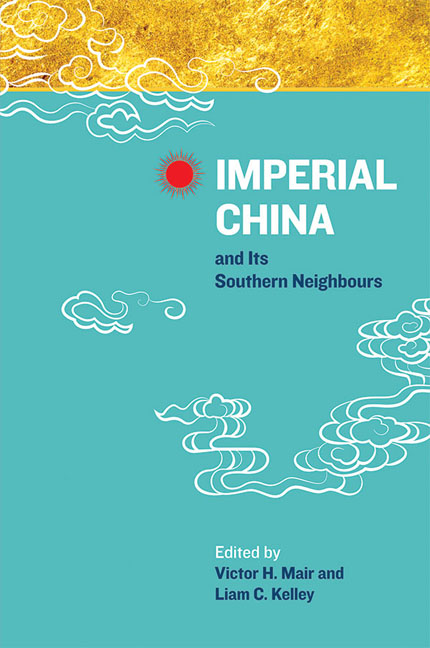Book contents
- Frontmatter
- Contents
- Preface
- The Contributors
- 1 Introduction: Imperial China Looking South
- 2 Layers of Meaning: Hairstyle and Yue Identity in Ancient Chinese Texts
- 3 Sinicization and Barbarization: Ancient State Formation at the Southern Edge of Sinitic Civilization
- 4 Clothes Make the Man: Body Culture and Ethnic Boundaries on the Lingnan Frontier in the Southern Song
- 5 What Makes a Chinese God? or, What Makes a God Chinese?
- 6 Dragon Boats and Serpent Prows: Naval Warfare and the Political Culture of China's Southern Borderlands
- 7 Inventing Traditions in Fifteenth-century Vietnam
- 8 Epidemics, Trade, and Local Worship in Vietnam, Leizhou Peninsula, and Hainan Island
- 9 Southeast Asian Primary Products and their Impact on Chinese Material Culture in the Tenth to Seventeenth Centuries
- 10 New Evidence on the History of Sino'arabic Relations: A Study of Yang Liangyao's Embassy to the Abbasid Caliphate
- 11 The Peacock's Gallbladder: An Example of Tibetan Influence in Late Imperial China
- 12 Transformation of the Yunnanese Community Along the Sino–burma Border During the Nineteenth and Early Twentieth Centuries
- 13 How the North Tried to Pacify the South Through Ritual Practices: On the Origins of the Guan Suo Opera in the Nineteenth Century
- 14 Realms Within Realms of Radiance, or, can Heaven Have Two Sons? Imperial China as Primus Inter Pares among Sino–pacific Mandala Polities
- Index
- Nalanda-Sriwijaya Series
8 - Epidemics, Trade, and Local Worship in Vietnam, Leizhou Peninsula, and Hainan Island
Published online by Cambridge University Press: 06 January 2018
- Frontmatter
- Contents
- Preface
- The Contributors
- 1 Introduction: Imperial China Looking South
- 2 Layers of Meaning: Hairstyle and Yue Identity in Ancient Chinese Texts
- 3 Sinicization and Barbarization: Ancient State Formation at the Southern Edge of Sinitic Civilization
- 4 Clothes Make the Man: Body Culture and Ethnic Boundaries on the Lingnan Frontier in the Southern Song
- 5 What Makes a Chinese God? or, What Makes a God Chinese?
- 6 Dragon Boats and Serpent Prows: Naval Warfare and the Political Culture of China's Southern Borderlands
- 7 Inventing Traditions in Fifteenth-century Vietnam
- 8 Epidemics, Trade, and Local Worship in Vietnam, Leizhou Peninsula, and Hainan Island
- 9 Southeast Asian Primary Products and their Impact on Chinese Material Culture in the Tenth to Seventeenth Centuries
- 10 New Evidence on the History of Sino'arabic Relations: A Study of Yang Liangyao's Embassy to the Abbasid Caliphate
- 11 The Peacock's Gallbladder: An Example of Tibetan Influence in Late Imperial China
- 12 Transformation of the Yunnanese Community Along the Sino–burma Border During the Nineteenth and Early Twentieth Centuries
- 13 How the North Tried to Pacify the South Through Ritual Practices: On the Origins of the Guan Suo Opera in the Nineteenth Century
- 14 Realms Within Realms of Radiance, or, can Heaven Have Two Sons? Imperial China as Primus Inter Pares among Sino–pacific Mandala Polities
- Index
- Nalanda-Sriwijaya Series
Summary
Vietnam is geographically very close to the Leizhou Peninsula and to Hainan Island, and the human connections between these sites go back thousands of years. But what is the history and nature of these connections?
We note that the Leizhou Peninsula and Hainan Island do not share land borders with Vietnam, as Guangxi and Yunnan provinces do, for example, and that they do not share Vietnam's strong economical development, so we may ask whether these entities were loosely or closely connected with the Red River Delta. We know rather little about the matter largely because trade in this region was primarily carried out by peddlers rather than by big merchants, and it therefore was rarely recorded. As a result, among all the Chinese peripheries, the connections between Vietnam and the Leizhou Peninsula and Hainan have been the least known.
Archaeological findings, however, suggest long and deep connections between the various coasts of this region. For example, among all the coasts of Guangdong, bronze drums are found most numerously in the Leizhou Peninsula. Together with the bronze drums found in Guangxi and on Hainan Island, this makes the Leizhou Peninsula stand out for its evident connections with Vietnam, and it highlights the unity of the Gulf of Tongking as one region from the time of antiquity. Local gazetteers of Hainan and Leizhou also record official connections between these coasts. A search of the biographies of scholars recorded in these local gazetteers indicates a striking phenomenon: the scholars of Leizhou and Hainan provided the majority of lower officers during the twenty years of Ming occupation of Vietnam (AD 1407–28).
This fact might be the tip of an iceberg. What connected the different peoples on these disconnected coasts still largely remains a mystery. This paper attempts to offer insights into these connections. It starts by examining epidemic data of the seventeenth and eighteenth centuries in this region, then moves on to look at the trade within, and the local worship shared throughout, the region. These data seem to suggest a rather surprising frequency and intensity of contacts among the peoples in this region. As such, this paper tries to shed some new light onto this shadowy corner of the South China Sea.
- Type
- Chapter
- Information
- Imperial China and Its Southern Neighbours , pp. 194 - 213Publisher: ISEAS–Yusof Ishak InstitutePrint publication year: 2015

